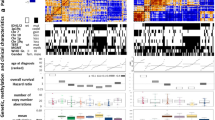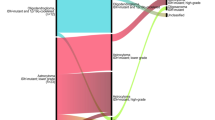Abstract
The outcome of patients with anaplastic gliomas varies considerably. Whether a molecular classification of anaplastic gliomas based on large-scale genomic or epigenomic analyses is superior to histopathology for reflecting distinct biological groups, predicting outcomes and guiding therapy decisions has yet to be determined. Epigenome-wide DNA methylation analysis, using a platform which also allows the detection of copy-number aberrations, was performed in a cohort of 228 patients with anaplastic gliomas (astrocytomas, oligoastrocytomas, and oligodendrogliomas), including 115 patients of the NOA-04 trial. We further compared these tumors with a group of 55 glioblastomas. Unsupervised clustering of DNA methylation patterns revealed two main groups correlated with IDH status: CpG island methylator phenotype (CIMP) positive (77.5 %) or negative (22.5 %). CIMPpos (IDH mutant) tumors showed a further separation based on copy-number status of chromosome arms 1p and 19q. CIMPneg (IDH wild type) tumors showed hallmark copy-number alterations of glioblastomas, and clustered together with CIMPneg glioblastomas without forming separate groups based on WHO grade. Notably, there was no molecular evidence for a distinct biological entity representing anaplastic oligoastrocytoma. Tumor classification based on CIMP and 1p/19q status was significantly associated with survival, allowing a better prediction of outcome than the current histopathological classification: patients with CIMPpos tumors with 1p/19q codeletion (CIMP-codel) had the best prognosis, followed by patients with CIMPpos tumors but intact 1p/19q status (CIMP-non-codel). Patients with CIMPneg anaplastic gliomas (GBM-like) had the worst prognosis. Collectively, our data suggest that anaplastic gliomas can be grouped by IDH and 1p/19q status into three molecular groups that show clear links to underlying biology and a significant association with clinical outcome in a prospective trial cohort.





Similar content being viewed by others
References
Bady P, Sciuscio D, Diserens A-C, Bloch J, van den Bent MJ et al (2012) MGMT methylation analysis of glioblastoma on the Infinium methylation BeadChip identifies two distinct CpG regions associated with gene silencing and outcome, yielding a prediction model for comparisons across datasets, tumor grades, and CIMP-status. Acta Neuropathol 124:547–560
Van den Bent MJ, Brandes AA, Taphoorn MJB, Kros JM, Kouwenhoven MCM et al (2013) Adjuvant procarbazine, lomustine, and vincristine chemotherapy in newly diagnosed anaplastic oligodendroglioma: long-term follow-up of EORTC brain tumor group study 26951. J Clin Oncol 31:344–350
Bettegowda C, Agrawal N, Jiao Y, Sausen M, Wood LD et al (2011) Mutations in CIC and FUBP1 contribute to human oligodendroglioma. Science 333:1453–1455
Brennan CW, Verhaak RGW, McKenna A, Campos B, Noushmehr H et al (2013) The somatic genomic landscape of glioblastoma. Cell 155:462–477
Cairncross G, Wang M, Shaw E, Jenkins R, Brachman D et al (2013) Phase III trial of chemoradiotherapy for anaplastic oligodendroglioma: long-term results of RTOG 9402. J Clin Oncol 31:337–343
Christensen BC, Smith AA, Zheng S, Koestler DC, Houseman EA et al (2011) DNA methylation, isocitrate dehydrogenase mutation, and survival in glioma. J Natl Cancer Inst 103:143–153
Erdem-Eraslan L, Gravendeel LA, de Rooi J, Eilers PHC, Idbaih A et al (2013) Intrinsic molecular subtypes of glioma are prognostic and predict benefit from adjuvant procarbazine, lomustine, and vincristine chemotherapy in combination with other prognostic factors in anaplastic oligodendroglial brain tumors: a report from EORTC stu. J Clin Oncol 31:328–336
Frattini V, Trifonov V, Chan JM, Castano A, Lia M et al (2013) The integrated landscape of driver genomic alterations in glioblastoma. Nat Genet 45:1141–1149
Hartmann C, Hentschel B, Wick W, Capper D, Felsberg J et al (2010) Patients with IDH1 wild type anaplastic astrocytomas exhibit worse prognosis than IDH1-mutated glioblastomas, and IDH1 mutation status accounts for the unfavorable prognostic effect of higher age: implications for classification of gliomas. Acta Neuropathol 120:707–718
Heaphy CM, de Wilde RF, Jiao Y, Klein AP, Edil BH et al (2011) Altered telomeres in tumors with ATRX and DAXX mutations. Science 333:425
Killela PJ, Reitman ZJ, Jiao Y, Bettegowda C, Agrawal N et al (2013) TERT promoter mutations occur frequently in gliomas and a subset of tumors derived from cells with low rates of self-renewal. Proc Natl Acad Sci USA 110:6021–6026
Koelsche C, Sahm F, Capper D, Reuss D, Sturm D et al (2013) Distribution of TERT promoter mutations in pediatric and adult tumors of the nervous system. Acta Neuropathol 126:907–915
Kros JM, Gorlia T, Kouwenhoven MC, Zheng P–P, Collins VP et al (2007) Panel review of anaplastic oligodendroglioma from European Organization For Research and Treatment of Cancer Trial 26951: assessment of consensus in diagnosis, influence of 1p/19q loss, and correlations with outcome. J Neuropathol Exp Neurol 66:545–551
Lai A, Kharbanda S, Pope WB, Tran A, Solis OE et al (2011) Evidence for sequenced molecular evolution of IDH1 mutant glioblastoma from a distinct cell of origin. J Clin Oncol 29:4482–4490
Liu X-Y, Gerges N, Korshunov A, Sabha N, Khuong-Quang D-A et al (2012) Frequent ATRX mutations and loss of expression in adult diffuse astrocytic tumors carrying IDH1/IDH2 and TP53 mutations. Acta Neuropathol 124:615–625
Louis DN, Ohgaki H, Wiestler OD, Cavenee WK, Burger PC et al (2007) The 2007 WHO classification of tumours of the central nervous system. Acta Neuropathol 114:97–109
Mur P, Mollejo M, Ruano Y, de Lope ÁR, Fiaño C et al (2013) Codeletion of 1p and 19q determines distinct gene methylation and expression profiles in IDH-mutated oligodendroglial tumors. Acta Neuropathol 126:277–289
Noushmehr H, Weisenberger DJ, Diefes K, Phillips HS, Pujara K et al (2010) Identification of a CpG island methylator phenotype that defines a distinct subgroup of glioma. Cancer Cell 17:510–522
Parsons DW, Jones S, Zhang X, Lin JC-H, Leary RJ et al (2008) An integrated genomic analysis of human glioblastoma multiforme. Science 321:1807–1812
R Core Team (2013) R: a language and environment for statistical computing. R Foundation for Statistical Computing, Vienna, Austria. http://www.R-project.org/
Schwartzentruber J, Korshunov A, Liu X-Y, Jones DTW, Pfaff E et al (2012) Driver mutations in histone H3.3 and chromatin remodelling genes in paediatric glioblastoma. Nature 482:226–231
Smith JS, Perry A, Borell TJ, Lee HK, O’Fallon J et al (2000) Alterations of chromosome arms 1p and 19q as predictors of survival in oligodendrogliomas, astrocytomas, and mixed oligoastrocytomas. J Clin Oncol 18:636–645
Sturm D, Bender S, Jones DTW, Lichter P, Grill J et al (2014) Paediatric and adult glioblastoma: multiform (epi)genomic culprits emerge. Nat Rev Cancer 14:92–107
Sturm D, Witt H, Hovestadt V, Khuong-Quang D-A, Jones DTW et al (2012) Hotspot mutations in H3F3A and IDH1 define distinct epigenetic and biological subgroups of glioblastoma. Cancer Cell 22:425–437
Turcan S, Rohle D, Goenka A, Walsh LA, Fang F et al (2012) IDH1 mutation is sufficient to establish the glioma hypermethylator phenotype. Nature 483:479–483
Verhaak RGW, Hoadley KA, Purdom E, Wang V, Qi Y et al (2010) Integrated genomic analysis identifies clinically relevant subtypes of glioblastoma characterized by abnormalities in PDGFRA, IDH1, EGFR, and NF1. Cancer Cell 17:98–110
Ward PS, Patel J, Wise DR, Abdel-Wahab O, Bennett BD et al (2010) The common feature of leukemia-associated IDH1 and IDH2 mutations is a neomorphic enzyme activity converting alpha-ketoglutarate to 2-hydroxyglutarate. Cancer Cell 17:225–234
Wick W, Hartmann C, Engel C, Stoffels M, Felsberg J et al (2009) NOA-04 randomized phase III trial of sequential radiochemotherapy of anaplastic glioma with procarbazine, lomustine, and vincristine or temozolomide. J Clin Oncol 27:5874–5880
Wick W, Meisner C, Hentschel B, Platten M, Schilling A et al (2013) Prognostic or predictive value of MGMT promoter methylation in gliomas depends on IDH1 mutation. Neurology 81:1515–1522
Wick W, Platten M, Meisner C, Felsberg J, Tabatabai G et al (2012) Temozolomide chemotherapy alone versus radiotherapy alone for malignant astrocytoma in the elderly: the NOA-08 randomised, phase 3 trial. Lancet Oncol 13:707–715
Wick W, Weller M, van den Bent M, Sanson M, Weiler M et al (2014) MGMT testing in neurooncology—a paradigm for prospects and challenges of biomarker-based treatment decisions. Nat Rev Neurol (in press)
Wiestler B, Capper D, Holland-Letz T, Korshunov A, von Deimling A et al (2013) ATRX loss refines the classification of anaplastic gliomas and identifies a subgroup of IDH mutant astrocytic tumors with better prognosis. Acta Neuropathol 126:443–451
Wiestler B, Claus R, Hartlieb SA, Schliesser MG, Weiss EK et al (2013) Malignant astrocytomas of elderly patients lack favorable molecular markers: an analysis of the NOA-08 study collective. Neuro Oncol 15:1017–1026
Yan H, Parsons DW, Jin G, McLendon R, Rasheed BA et al (2009) IDH1 and IDH2 mutations in gliomas. N Engl J Med 360:765–773
Acknowledgments
The work was supported by the German Cancer Aid (Deutsche Krebshilfe, “Molecular classification of anaplastic gliomas in the NOA-04 trial”, project 110624) to WW and MW and the Personalized Oncology Program of the NCT Heidelberg.
Author information
Authors and Affiliations
Corresponding author
Additional information
B. Wiestler, D. Capper, M. Sill contributed equally to this manuscript.
Electronic supplementary material
Below is the link to the electronic supplementary material.
Rights and permissions
About this article
Cite this article
Wiestler, B., Capper, D., Sill, M. et al. Integrated DNA methylation and copy-number profiling identify three clinically and biologically relevant groups of anaplastic glioma. Acta Neuropathol 128, 561–571 (2014). https://doi.org/10.1007/s00401-014-1315-x
Received:
Revised:
Accepted:
Published:
Issue Date:
DOI: https://doi.org/10.1007/s00401-014-1315-x




